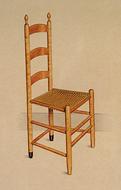The Shaker Design Philosophy
I love this design philosophy of the Shakers…goes for designing anything.
“Don’t make something unless it is both necessary and useful; but if it is both necessary and useful, don’t hesitate to make it beautiful.”
The Shaker design philosophy is one of prioritization: their main priority is to be necessary and useful. Then, once that has been achieved, make something beautiful. To me this is a great way to explain design, without sacrificing beauty or expression of the designer. Many times I’ve got in trouble when trying to articulate this sentiment, such as my recent post on 5 Principles to Design By, in which I suggest that “Design is not Art”. I tell myself that design is not art so I can focus on the idea that design should be functional above all else, and once that is achieved the designer can imbue it with other properties.
 The Shaker philosophy has led to an amazing array of designs. The Shakers invented, among other things, the circular saw, the washing machine, and the flat broom. They are also well-known for their simple, durable furniture. My wife and I have longed to buy Shaker furniture to fill our house, but because it is always made by hand and with solid wood it is relatively expensive. One nice example is the ladder-back chair, a design which we take for granted nowadays. An interesting version of this design is the Shaker tilting chair, with ball-and-socket joints on its rear legs so one can lean back in it without breaking the chair legs.
The Shaker philosophy has led to an amazing array of designs. The Shakers invented, among other things, the circular saw, the washing machine, and the flat broom. They are also well-known for their simple, durable furniture. My wife and I have longed to buy Shaker furniture to fill our house, but because it is always made by hand and with solid wood it is relatively expensive. One nice example is the ladder-back chair, a design which we take for granted nowadays. An interesting version of this design is the Shaker tilting chair, with ball-and-socket joints on its rear legs so one can lean back in it without breaking the chair legs.
Ward Cunningham, inventor of the wiki, has a page dedicated to Shaker philosophy, which should come as no surprise given the simple utility of the software.
The Shakers themselves were an interesting lot, an extremely religious group started in Manchester, England in 1700s. They moved (9 of them) to the Watervliet area in New York in 1770s. The Shakers are very religious, and one of their strict beliefs hinders their growth as a community. That belief is in celibacy, or simply not having sex. Because of this their numbers have never been large and the only way that a Shaker community can form or survive is by conversion. By most accounts, the only remaining community of Shakers in the world is in Sabbathday Lake, Maine.
Even so, their philosophy lives on in countless designs refined over the years.
More on Shakers and their designs:
- A Shaker Approach to Web Site Design by Michael Levi
- The Shakers of New England (a nice, quick overview)
- Shakers Wikipedia entry
- Ward Cunningham’s Shaker Quote page
- Shaker tilting chair in the National Gallery of Art
Previous